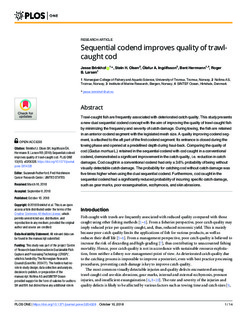Sequential codend improves quality of trawlcaught cod
Peer reviewed, Journal article
Published version
Permanent lenke
http://hdl.handle.net/11250/2569551Utgivelsesdato
2018Metadata
Vis full innførselSamlinger
- Articles [3001]
- Publikasjoner fra CRIStin [3025]
Originalversjon
10.1371/journal.pone.0204328Sammendrag
Trawl-caught fish are frequently associated with deteriorated catch quality. This study presents a new dual sequential codend concept with the aim of improving the quality of trawl-caught fish by minimizing the frequency and severity of catch damage. During towing, the fish are retained in an anterior codend segment with the legislated mesh size. A quality improving codend segment, is attached to the aft part of the first codend segment. Its entrance is closed during the towing phase and opened at a predefined depth during haul-back. Comparing the quality of cod (Gadus morhua L.) retained in the sequential codend with cod caught in a conventional codend, demonstrated a significant improvement in the catch quality, i.e. reduction in catch damages. Cod caught in a conventional codend had only a 3.6% probability of being without visually detectable catch damage. The probability for catching cod without catch damage was five times higher when using the dual sequential codend. Furthermore, cod caught in the sequential codend had a significantly reduced probability of incurring specific catch damage, such as gear marks, poor exsanguination, ecchymosis, and skin abrasions.
